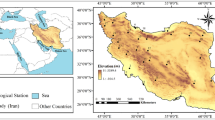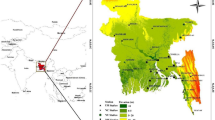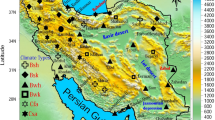Abstract
This study presents an alternative approach for computing the Standardized Precipitation Evapotranspiration Index (SPEI). The proposed approach, called the Simplified Standardized Precipitation-Evapotranspiration Index (SSPEI), uses the Box-Cox transformation to normalize water balance anomalies (WBA) and subsequently convert the transformed series into the standard normal distribution (SND) using the Z-score formula. This approach is tested in 45 synoptic stations with varied climates across Iran. The stations’ monthly total precipitation and average minimum and maximum air temperatures for 1971–2017 were used to compute the potential evapotranspiration and eventually WBA series needed for SPEI/SSPEI computation. According to the findings, the skewness of the Box-Cox transformed series of almost all the time scales and stations are close to zero. Therefore, the transformed WBA series can be confidentially used for computing SSPEI. The normality of the computed SSPEI series and the SPEI time series computed with the Log-logistics (LLG) and Generalized Extreme Value (GEV) distributions for the studied stations were examined using different normality assessment measures. The computed SSPEI for all the time scales and stations was found to be normally distributed, and the percentage of the SSPEI series with SND was comparable to those of the SPEILLG and SPEIGEV time series. However, SSPEI was superior to SPEILLG and SPEIGEV as it is simple in computation, requires no distribution fitting, and never results in null values due to computation failure, as is common with SPEI.










Similar content being viewed by others
Data Availability
The datasets generated during and/or analysed during the current study are available from the corresponding author upon reasonable request.
References
Beguería S, Vicente-Serrano SM, Reig F (2014) Standardized precipitation evapotranspiration index (SPEI) revisited: parameter fitting, evapotranspiration models, tools, datasets and drought monitoring. Int J Climatol 34:3001–3023
Box GEP, Cox DR (1964) An analysis of transformations. J Roy Stat Soc Ser B (Methodol) 26:211–243
Guenang G, Merlin, Mkankam Kamga F (2014) Computation of the standardized precipitation index (SPI) and its use to assess drought occurrences in Cameroon over recent decades. J Appl Meteorol Climatol 53:2310–2324
Guttman NB (1998) Comparing the palmer drought index and the standardized precipitation index1. JAWRA J Am Water Resour Assoc 34:113–121
Guttman NB (1999) Accepting the standardized precipitation index: A calculation algorithm1. JAWRA J Am Water Resour Assoc 35:311–22
Hargreaves GH, Samani ZA (1985) Reference crop evapotranspiration from temperature. Appl Eng Agric 1:96–99
Hayes M, Svoboda M, Wall N, Widhalm M (2011) The lincoln declaration on drought indices: Universal meteorological drought index recommended. Bull Am Meteorol Soc 92:485–488
Mckee T, Doesken N, Kleist J, Kleist J (1993) The relationship of drought frequency and duration to time scales. In: 8th Conference on Applied Climatology, Anaheim. pp 179–184
Moriasi DN, Arnold JG, Van Liew MW, Bingner RL, Harmel RD, Veith TL (2007) Model evaluation guidelines for systematic quantification of Accuracy in Watershed Simulations. Trans ASABE 50:885–900
Nash JE, Sutcliffe JV (1970) River flow forecasting through conceptual models part I — a discussion of principles. J Hydrol 10:282–290
Pieper P, Düsterhus A, Baehr J, Baehr J (2020) A universal standardized precipitation index candidate distribution function for observations and simulations. Hydrol Earth Syst Sci 24:4541–4565
Quiring SM (2009) Monitoring Drought: An evaluation of meteorological drought indices. Geogr Compass 3:64–88
Raziei T (2017) Köppen-Geiger climate classification of Iran and investigation of its changes during 20th century. J Earth Space Phys 43:419–439
Raziei T (2021a) Performance evaluation of different probability distribution functions for computing Standardized Precipitation Index over diverse climates of Iran. Int J Climatol 41:3352–3373
Raziei T (2021b) Revisiting the rainfall anomaly index to serve as a simplified standardized precipitation index. J Hydrol 602:126761
Raziei T (2022a) Climate of Iran according to Köppen-Geiger, Feddema, and UNEP climate classifications. Theor Appl Climatol 148:1395–416
Raziei T (2022b) Improving the normalization procedure of the simplified standardized precipitation index (SSPI) using Box–Cox transformation. Stoch Environ Res Risk Assess 37:925–951
Shapiro SS, Wilk MB (1965) An analysis of variance test for normality (complete samples). Biometrika 52:591–611
Spade D, Beurs K, Shafer M, Shafer M (2020) Major over- and underestimation of drought found in NOAA’s climate divisional SPI dataset. J Appl Meteorol Climatol 59:1469–1480
Stagge JH, Tallaksen LM, Gudmundsson L, Van Loon AF, Stahl K (2015) Candidate distributions for climatological drought indices (SPI and SPEI). Int J Climatol 35:4027–4040
Stagge JH, Tallaksen LM, Gudmundsson L, Van Loon AF, Stahl K (2016) Response to comment on ‘candidate distributions for climatological drought indices (SPI and SPEI). Int J Climatol 36:2132–2138
Stephens MA (1974) EDF statistics for goodness of fit and some comparisons. J Am Stat Assoc 69:730–737
Svensson C, Hannaford J, Prosdocimi I (2017) Statistical distributions for monthly aggregations of precipitation and streamflow in drought indicator applications. Water Resour Res 53:999–1018
Tsakiris G, Pangalou D, Vangelis H, Vangelis H (2007) Regional Drought assessment based on the reconnaissance drought index (RDI). Water Resour Manag 21:821–833
Tsakiris G, Vangelis H (2005) Establishing a drought index incorporating evapotranspiration. Eur Water 9(10):3–11
UNEP (1997) World atlas of desertification: second edition. United Nations Environment Programme. https://wedocs.unep.org/20.500.11822/30300
Vicente-Serrano SM, Beguería S (2016) Comment on ‘candidate distributions for climatological drought indices (SPI and SPEI)’ by James H. Stagge et al. Int J Climatol 36:2120–2131
Vicente-Serrano SM, Beguería S, Juan I, López-Moreno, Juan I, López-Moreno (2010) A multiscalar drought index sensitive to global warming: the standardized precipitation Evapotranspiration Index. J Clim 23:1696–1718
Wilks DS (2011) Statistical methods in the atmospheric sciences, 3rd edn. Elsevier Academic Press, Oxford
WMO (2006) Drought monitoring and early warning: Concepts, progress and future challenges. Meteorol Organ, Geneva, Switzerland, WMO-No 1006
Wu H, Svoboda MD, Hayes MJ, Wilhite DA, Wen F (2007) Appropriate application of the standardized precipitation index in arid locations and dry seasons. Int J Climatol 27:65–79
Funding
The authors declare that no funds, grants, or other support were received during the preparation of this manuscript.
Author information
Authors and Affiliations
Contributions
All authors contributed to the study’s conception and design. Material preparation, data collection, and analysis were performed by T Raziei and M Miri. All authors read and approved the final manuscript.
Corresponding author
Ethics declarations
Ethical Approval
Not applicable.
Consent to Participate
Not applicable.
Consent to Publish
Not applicable.
Competing Interests
The authors have no competing interests to declare that are relevant to the content of this article.
Additional information
Publisher’s Note
Springer Nature remains neutral with regard to jurisdictional claims in published maps and institutional affiliations.
Rights and permissions
Springer Nature or its licensor (e.g. a society or other partner) holds exclusive rights to this article under a publishing agreement with the author(s) or other rightsholder(s); author self-archiving of the accepted manuscript version of this article is solely governed by the terms of such publishing agreement and applicable law.
About this article
Cite this article
Raziei, T., Miri, M. An Alternative Approach for Computing the Standardized Precipitation-Evapotranspiration Index (SPEI). Water Resour Manage 37, 4123–4141 (2023). https://doi.org/10.1007/s11269-023-03542-9
Received:
Accepted:
Published:
Issue Date:
DOI: https://doi.org/10.1007/s11269-023-03542-9




